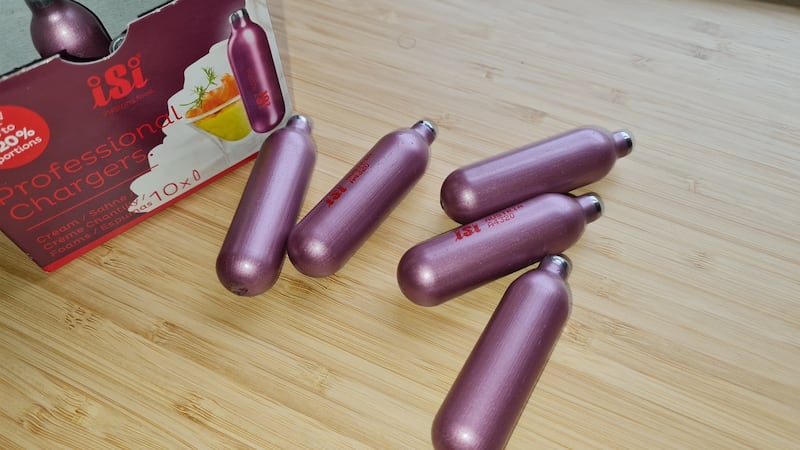It took less than 48 hours for the package of 10 “cream whipper canisters” to arrive after it was ordered from an Irish website. Each canister contained approximately one dose of nitrous-oxide.
Ostensibly these small cylinders, which resemble silver bullets, are for making whipped cream using a specialised dispenser. But in recent years, and particularly during the Covid-19 lockdowns of the past 18 months, they have become an increasingly popular way of getting high.
Various reasons have been put forward for the increase in the illicit use of nitrous-oxide, which is also known as laughing gas, hippy crack or whippets.
A drought of cannabis as a result of travel restrictions has led to young people using nitrous as a substitute, says Fine Gael TD for Dublin Mid-West Emer Higgins. Her constituency colleague, Mark Ward of Sinn Féin, has blamed boredom caused by the closure of youth services during Covid. It helps that they are also cheap, going for about €1 a canister on the street.
But the main reason for the drug's popularity is perhaps how easily it is obtained despite restrictions around its sale. A few minutes on Google will throw up dozens of catering websites that will sell the canisters to anyone with a credit card.
In a way Ireland is just catching up with the rest of the planet. According to the 2019 Global Drug Survey, nitrous is now the 10th most popular illicit drug in the world.
Evidence of it use in Irish communities is widespread in the form of discarded canisters on streets and in parks. According to Dublin City Council, canisters are being found by waste management all over the city. “They are mainly found where there are large gatherings,” a spokesman said.
Two shipments
Revenue made no seizures of nitrous-oxide between 2015 and 2019, but in the first half of 2020 seized two shipments, totalling 14,400 canisters, which were believed to be destined for the illicit market.
“Revenue’s customs officers are fully aware of the emerging trend over recent months of the misuse of nitrous-oxide, and are closely monitoring importations of the product into the State,” a spokeswoman said.
Nitrous oxide use has been around for a long time, says Anna Quigley of Dublin’s Citywide Drugs Crisis Campaign. In the 1980s it was used by young people alongside glue and aerosols. Public concern about solvent abuse led the government to introduce legislation in 1991 making it a crime to sell a child any substance likely to be inhaled “for the purpose of causing intoxication”.
The law, along with changing drugs trends, meant nitrous use faded into the background for a time. “But during Covid it appears to have come back in a really big way,” says Quigley. “We have gotten reports from a lot of areas of it being used.”
Dr Shaeraine Raaj, the senior registrar in psychiatry at the Crumlin Community Mental Health Service, says people are using it "as a substitute because they can't get their hands on their drug of choice, which is cocaine or cannabis or benzos".
A garda involved in drug enforcement in the midlands says the use of nitrous has been popular at festivals over the years, “nearly as a novelty drug”. Users would take it while on other drugs such as ecstasy “but it wouldn’t be the main event”.
Now it has become the primary drug for many young people, according to the garda. “Young lads who might not be into the drug scene are taking it because it’s seen as harmless,” he says, citing concerns raised with him by local parents. “That said, I don’t want to overstate it. No one is robbing shops to get money to buy this stuff.”
A 2019 survey by the HSE and Trinity College Dublin found that 25 per cent of drug users who attended festivals that year consumed nitrous.
Parties
“It’s a recreational drug,” says Tony Duffin, chief executive of the Ana Liffey Drug Project, which offers assistance to problem drug users. “It’s not something that is really on our radar for drug use, like heroin or crack cocaine.”
Gavin (not his real name), a 19-year-old who works with a youth project in the Leinster area, does not see what the fuss is about. He has taken nitrous on occasion, usually at parties. “I have seen drugs devastate so many lives. But I haven’t seen much harm from [nitrous-oxide]. Lots of people are using it but it’s not causing loads of problems aside from the litter.”
It is a perhaps understandable view. Nitrous is typically consumed by emptying the canisters into balloons, from which the gas can then be easily inhaled. The high lasts between 30 and 60 seconds and usually results in little more than giggling and some euphoria. Adverse after-effects are rare and it is not thought to have physically addictive properties.

The Health Research Board said this week it has recorded no poisoning deaths "as a specific result of nitrous-oxide intake" since 2004. However, it added that its records currently date only up to 2017, as Covid restrictions meant it has not been able to access more recent coroner data.
There are currently no young people receiving treatment from the HSE adolescent addiction services for use of the drug. The National Poisons Information Centre said it has recorded seven cases of people hospitalised for nitrous-oxide ingestion since 2005, with three of those occurring since the start of 2020. That data does not reveal if victims ingested the drug recreationally or by accident. (As well as being used in catering, nitrous oxide is used in pain relief during minor surgery and in certain other industrial roles.)
Figures from the UK, where the drug has been more popular for a longer period, are more concerning. There were 36 deaths associated with nitrous-oxide there between 2001 and 2016.
Hospital
On May 20th, 2020, a 15-year-old boy was found slumped over a wall in Ballycullen, Dublin, having taken nitrous oxide. The boy was rushed to hospital, where he later died. It is not clear if the drug caused the teenager's death; it is understood another substance was also found in his system. Nevertheless, a short time later the HSE added nitrous to its official list of dangerous drugs. An inquest into the death is due shortly.
Following the boy’s death Minister of State for Health Frank Feighan ordered the HSE to gather information on the prevalence of nitrous. It reported back that while there had been an increase in use among under-18s over the past two years, “there was limited information to identify emerging harms” compared with other more well-known drugs, a department spokeswoman said.
Rather than launching a national awareness campaign, it was decided to initiate local campaigns in specific areas where use of the drug was a particular concern.
Nitrous oxide is undoubtedly a dangerous substance, according to Dr Raaj, who says he is aware of increasing numbers of people being admitted to hospital with paralysis and brain damage as a result of nitrous-oxide use. Heavy use can impair the creation of vitamin B12, leading to toxicity and nerve damage, including to the spine.
Most other dangers relate to how nitrous is inhaled rather than the substance itself. Users have suffocated through overuse or by putting bags over their head to accentuate the high. Others have suffered frostbite from inhaling the gas directly from the pressurised canisters.
The situation in Britain, where nitrous is now the second most popular drug among young people after cannabis, has prompted the government there to consider further restricting its sale.
Fine Gael’s Emer Higgins would like to see her party take similar action here. “We need to protect young people against the potentially damaging, harmful and deadly side effects of nitrous-oxide misuse.”
Legal uses
As well as being restricted under the 1991 Act, sale of nitrous for its psychoactive properties is also banned under 2010 legislation. However, nitrous is not a controlled drug, meaning it is not a crime to possess it. Its various legal uses mean it is also extremely difficult to prove someone is selling the drug for illicit purposes.
Several Irish catering companies told The Irish Times this week that they have stopped selling the substance to retail customers over concerns about its illicit use. However, it remains widely available online, including on eBay, where €75 buys 120 canisters.
“I really feel we should have a bit more corporate responsibility on the part of big corporations. That’s one thing that could help overnight,” said Higgins. “One of the issues I have is the likes of Google are effectively profiteering from it because they are selling ads.”
You can go online and search for “gas canister” and it will take you to a website showing you how to purchase it in a very discreet way, she says. “These are websites that are clearly selling for purposes other than whipped cream.”












